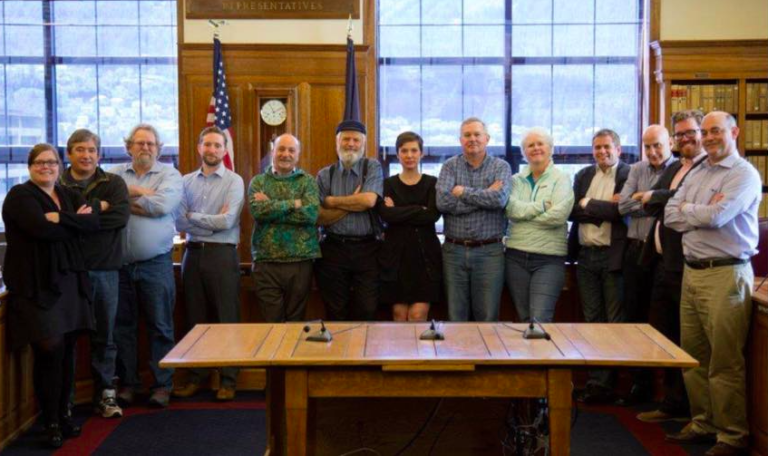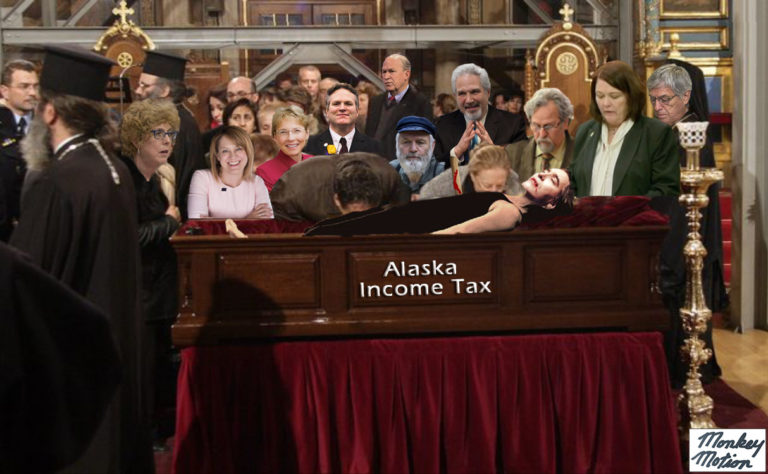
NEED A SLUSH FUND? CREATE A COMMISSION
There may be a fiscal crisis in the State of Alaska, but that’s not stopping House Democrats from doing what Democrats like to do: add new agencies and even more taxes to fund them.
Next Wednesday, the day before pink slips are sent to thousands of State of Alaska employees, the House Natural Resources Committee, led by Reps. Geran Tarr and Andy Josephson, will hold a hearing on one of their favorite projects: Creating a commission on climate change within the Office of the Governor.
The cost for such a commission would be paid for with a tax of 1 cent on every barrel of oil through the Trans Alaska Pipeline System.
That equates to $5,000 a day, or $1.825 million per year, at current production levels.
The Tarr-Josephson bill, HB 173, establishing the Alaska Climate Change Response Commission, will be heard at 1 pm, May 31 in Room 124 of the Capitol. It will be teleconferenced.
By then, the Legislature will have blown through 14 days of a special session called by the governor to pass a budget and create a funding plan for that budget.
Neither of those tasks have been completed, and the Legislature has basically disassembled for the long Memorial Day weekend.
Both Tarr and Josephson have been assigned to the House Democrats’ side of the conference committee on HB 111, which seeks to change taxes and tax credits on barrels of oil. It’s a critical piece of legislation that has had versions pass both the House and Senate. Neither Tarr nor Josephson has agreed to meet in conference committee on that legislation until after Memorial Day.
Tarr and Josephson’s plan to use special session time on their commission bill drew swift rebuke from Sen. Cathy Giessel, who chairs the Senate Resources Committee.
“Alaska is in a recession. Our economy is hampered by our government’s unstable public finances. While multi-billion dollar questions await answers, the State House decided today was a good time to advance an environmentalist agenda.”
Her vice-chair, Sen. John Coghill of North Pole, echoed the sentiment.
MAJOR COMMISSION, MINOR EXPECTATIONS
The Climate Change Commission would be made up of 15 members, including five state commissioners and nine elected municipal officials from around the state. An executive director would be hired to advance the commission’s agenda, and the primary work product of the commission would be to seek grants, aid, and other financing to assist rural communities.
The commission would become part of the Governor’s Office. It would apply for grants for agencies and tribes.
“The federal government has spent about $38 billion on climate change, directly and through aid, since 2003. Globally, public and private entities spend about $392 billion per year on climate change financing. Alaska is missing out on these opportunities due to a lack of a dedicated office, an assistance program, or governmental spending on the upfront costs of securing climate change aid,” Tarr and Josephson said in their sponsor statement.
Beyond grant writing, the commission would monitor climate change, consult with experts, publish reports, coordinate with the University of Alaska, advance green technology, reach out to non-profits and rural communities, and seek out ways to reduce greenhouse gas emissions in the public and private sectors, the sponsors say.
It will develop a program to distribute money from a climate change response fund that it will amass, according to Tarr and Josephson.
But the kicker is how the commission would be funded. A new tax on oil would be created. Called a surcharge, this one-cent tax would be added onto the tax already dedicated to the Spill Prevention and Response Fund, which has received $2 million per year over the past four years.
The Climate Change Response Fund will have a limit of $50 million after which the surcharge will not be collected, the sponsors say.
How that $50 million would be spent is not specified, but it appears to be a type of slush fund that the Governor’s Office would use to send people to conferences and travel around the state, with no deliverables required. The 15 commissioners would earn per diem and travel, but would not otherwise receive compensation.
The bill is supported by dozens of established environmental groups and new protest groups that have formed in response to the electoral losses of Hillary Clinton and Bernie Sanders. Those groups include Indivisible Alaska, Alaskans Stronger Together, March on Fairbanks, Our Revolution Alaska, and Take Action Skagway.
The support documents for the bill include no information on what the carbon footprint of the commission itself would be, for its offices and well-funded airline travel budget, should it pass both House and Senate.















